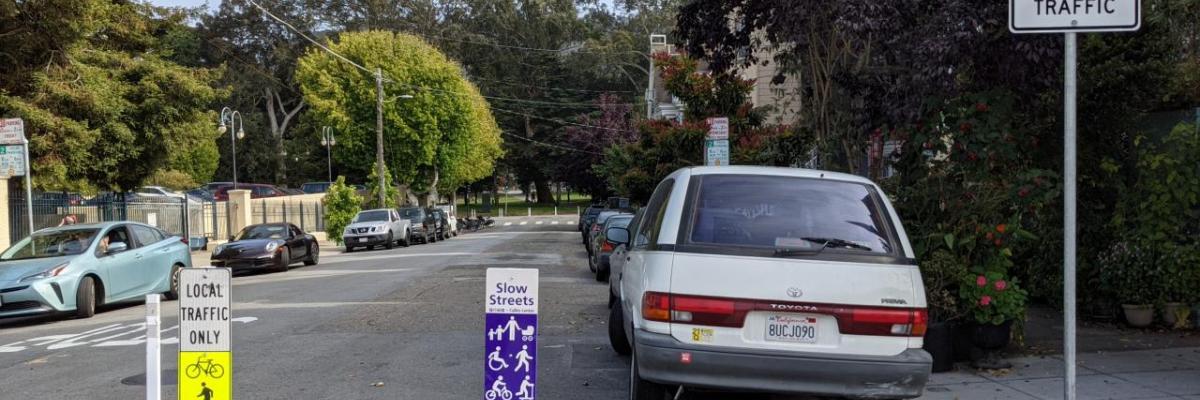Post-Pandemic Slow Streets
September 3rd Public Hearing Results
Additionally, at the August 3, 2021, SFMTA Board of Directors meeting, Golden Gate Avenue and Lake Street Slow streets were also approved to extend beyond the pandemic and state of emergency. Outreach and design processes for both those Slow Streets are planned to begin in Fall 2021. Stay up to date on those planned efforts by signing up for email and text updates.
Slow Streets are temporary traffic restrictions implemented during the COVID-19 pandemic in San Francisco. These restrictions are authorized to continue 120 days beyond the lifting of the State of Emergency.
Many Slow Streets have become community gathering places and safe spaces for people to share the roadway. The SFMTA has identified initial recommendations for post-pandemic Slow Streets, and design work is ongoing for four Slow Streets corridors. All Slow Streets are being evaluated for a post-pandemic future.
For more information on the Slow Streets program, visit the main webpage at SFMTA.com/SlowStreets.
Post-Pandemic Slow Streets Process
To become a lasting part of the city’s infrastructure beyond the pandemic, a Slow Street corridor must meet feasibility criteria, be reauthorized as a post-pandemic Slow Street, and complete an outreach process to determine the design of lasting Slow Street materials.
Post-Pandemic Slow Street Feasibility Criteria:
The following criteria are used to determine if a temporary Slow Street could be extended beyond the State of Emergency:
-
Neighborhood Residential Street – At a minimum, the street should be classified as a neighborhood residential street with low traffic volumes.
-
Support for Permanence - Strong support is shown from residents living on the Slow Street and the overall neighborhood for permanent changes. This is measured by community outreach efforts and evaluation tools like Slow Street perception surveys.
-
Local Community Partner – Ideally, the designated street has an identified local community group or organization that supports the Slow Street.
-
Consistency with Plans – The designation of a Slow Street on a corridor is consistent with city planning efforts (e.g., the corridor has been identified in the Bike Network or the Green Connections Plan, or it’s been identified as a pedestrian- or bike-priority street in the General Plan or another community planning effort).
-
Traffic Data Evaluation – Traffic volume data shows that a street's designation as a Slow Street has not had negative impacts on the surrounding transportation network.
If an existing Slow Street corridor meets all criteria, it can advance to the reauthorization and design approvals.
Approval Process
A post-pandemic Slow Street is approved in two separate actions by two distinct parts of the SFMTA.
The AUTHORIZATION of a Slow Street is granted by the SFMTA Board of Directors. This authorization allows the designation of a Slow Street corridor to extend into the future beyond the declaration of the State of Emergency.
The DESIGN of a Slow Street is determined through a community outreach process and approved by the City Traffic Engineer following a public hearing process.
Post-Pandemic Slow Streets in Progress
- Lake Slow Street
- Evaluation: Completed
- Outreach/Design: See the project webpage
- Authorization: Approved August 3, 2021
- Design Approval: TBD
- Implementation: TBD
- Golden Gate Avenue
- Evaluation: Completed
- Outreach/Design: See the project webpage
- Authorization: Approved August 3, 2021
- Design Approval: Approved July 8, 2022
- Implementation: TBD
- Sanchez Street
- Evaluation: Completed
- Outreach/Design: See the virtual open house
- Authorization: Approved August 3, 2021
- Design Approval: Approved September 10, 2021
- Implementation: Substantially implemented
- Shotwell Street
- Evaluation: Completed
- Outreach/Design: See the virtual open house
- Authorization: Approved August 3, 2021
- Design Approval: Approved September 10, 2021
- Implementation: Fully implemented
Page Slow Street
The Slow Street changes on Page Street between Gough and Stanyan will combine with other Page Street roadway changes including the 2019 Page Street Bikeway Pilot Project. This combined Page Slow Street project will allow more implementation and evaluation of temporary traffic changes (including on Haight Street near Octavia Boulevard) and public engagement prior to finalizing and approving more permanent measures.
Funding
This program was made possible in part by Proposition K Sales Tax dollars provided by the San Francisco County Transportation Authority.


